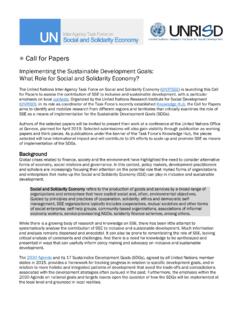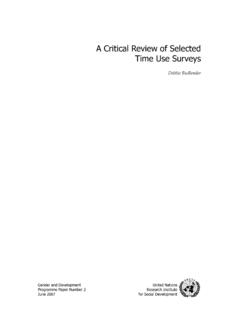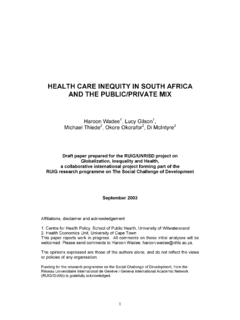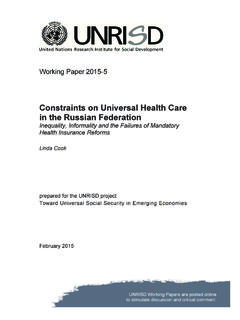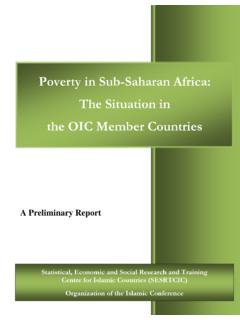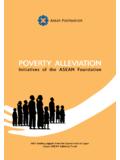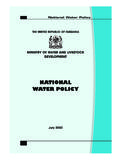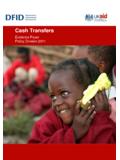Transcription of EXPLAINING BOTSWANA'S ECONOMIC GROWTH …
1 UNRISD UNITED NATIONS RESEARCH INSTITUTE FOR social development Institutional Dynamics of Sustained Rapid ECONOMIC GROWTH with Limited Impact on poverty Reduction Gervase S. Maipose University of botswana prepared for the UNRISD project on poverty Reduction and Policy Regimes January 2008 Geneva UNRISD was established in 1963 as an autonomous space within the UN system for the conduct of policy-relevant, cutting-edge research on social development that is pertinent to the work of the United Nations Secretariat; regional commissions and specialized agencies; and national institutions. Our mission is to generate knowledge and articulate policy alternatives on contemporary development issues, thereby contributing to the broader goals of the UN system of reducing poverty and inequality, advancing well-being and rights, and creating more democratic and just societies.
2 UNRISD, Palais des Nations 1211 Geneva 10, Switzerland Tel: +41 (0)22 9173020 Fax: +41 (0)22 9170650 Copyright United Nations Research Institute for social development This is not a formal UNRISD publication. The responsibility for opinions expressed in signed studies rests solely with their author(s), and availability on the UNRISD Web site ( ) does not constitute an endorsement by UNRISD of the opinions expressed in them. No publication or distribution of these papers is permitted without the prior authorization of the author(s), except for personal use. INTRODUCTION AND PAPER OUTLINE Introduction botswana is widely cited as Africa s foremost success story.
3 According to the recent IMF Surveillance report, as quoted by the Government of botswana (Budget Speech 2007:1), botswana has been among the world s fastest growing economies over the past 40 years, with an impressive record of prudent macroeconomic policies and good governance, which has moved the country from being one of the poorest in the world at independence in 1966 to the current rating of upper-middle income range. Real GDP GROWTH averaged 9 percent between 1965/66 and 2005/06 an outstanding and uncontested ECONOMIC performance record of any country in the world (Leith 2005:4).
4 The country is also the longest liberal democracy in Africa with good governance record and market based economy; and the country has relatively strong checks and balances, notably for ensuring public accountability and rules for both public spending and general ECONOMIC management. Known for huge reserves of mineral wealth, especially diamonds, which are the main engine of ECONOMIC development , the country s development path has been steered in a manner that has largely avoided both the resource curse and mineral-led economy syndrome - the Dutch However, the country s exceptional real GDP GROWTH rate, sustained since independence in 1966, has had limited impact on ECONOMIC diversification and most importantly on alleviating high unemployment/ poverty levels which are relatively too high for a country at this level of GDP per capita income.
5 Generally viewed as pronounced deprivation in wellbeing or lack of resources and/or capabilities necessary to meet basic human needs, poverty eradication is one of the main development challenges that botswana faces. It should be noted from the outset that development is a process and does not take place in vacuum but in a given institutional context which influence policy as well as the quality of development outcome (Lipton 1977; Leftwich, 1995, 2006; Bates, 2002; World Bank, 2004). It is therefore imperative, as the main concern of this paper, to determine the political and institutional dynamics of poverty and inequality in botswana s development .
6 Taking the policy regime approach/orientation, the broad crucial question is why and what is the institutional context to explain the situation, including what is being done to sustain GROWTH with concerted/focused efforts to address unemployment/ poverty problem the pro-poor development in order to attain the Millennium development Goals (MDGs) which in botswana entails eradicating poverty by 2016? Thus, the main objective of this chapter is to illuminate the political and institutional dynamics of sustained rapid ECONOMIC GROWTH with limited impact on poverty alleviation, and shed light on challenges for pro-poor, inclusive development process.
7 It is argued that the inherited and new institutions of political, ECONOMIC and legal restraint proved robust in the face of initial large aid inflow and spectacular mineral rents, producing a GROWTH pattern that has been both rapid and cautious, but with limited impact on ECONOMIC diversification and poverty alleviation, regarded as the main development challenge. Attempt is made to explore why and how the institutional arrangements of a 2developmental state in botswana appears to have been sufficiently dedicated to rapid ECONOMIC GROWTH with what looks like a basic needs approach to poverty reductions until quite recently.
8 Yet GROWTH is valued not because it further enriches the already well-off, but because it gives an opportunity to significantly and lastingly improve standards of living for the majority, including the poor. For a country to achieve the characteristics of development it is a requirement that poverty is alleviated, income levels are considerably improved, and that resources and opportunities are distributed by a modern state in order for all segments of society to benefit (Seers, 1972; Adelman, 2003; World Bank 2001,2006). poverty reduction is not only a matter of appropriate policies and strategies, but also and (probably) most importantly a matter of appreciating political forces and coalition that influence demand, design and implementation of GROWTH and development strategies that are pro-poor and are expressed and sustained in the enabling institutional arrangements inherited and enacted by the state ( Leftwich 1995; 2006).
9 Taking a policy regime orientation, the chapter starts with a synoptic analysis of the orientation of the indigenous nature of the botswana developmental state and governance aspects providing a general background for appreciating GROWTH experience in policy regime episodes and subsequent analysis of macro- ECONOMIC situation and dynamics of political economy. The second part illuminates institutional dynamics of GROWTH focusing on state resource mobilization financial and human capital and significance of state good management aspects. The chapter ends with an analysis of state management structure and institutional entanglement, offering lessons as well as some development challenges facing botswana .
10 The thrust is towards EXPLAINING institutional context of the botswana s developmental state and how this helped to shape leadership interest in GROWTH and stability leading to high GROWTH rate with limited impact on poverty alleviation outcomes, determined by microeconomic agents responding to policy environment and external shocks GROWTH and poverty Dynamics in Policy Regime Episodes botswana s development policies as well as strategies for poverty reduction are integrated into the country s broader National ECONOMIC development Planning, guided since independence by the four national principles of, Democracy, development , Self reliance, and Unity.

